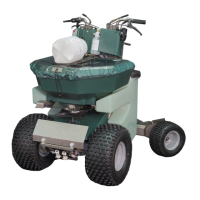Periodically check permagreen.com for available Triumph updates
Copyright © 2018, Perma-Green Supreme, Inc. All rights reserved. No part of this book covered by the copyright hereon may be reproduced
or copied in any form or by any means, except as permitted by the proprietary data statement for use with Perma-Green Supreme. Inc.
equipment, without the written permission of Perma-Green Supreme, Inc. Triumph is protected by US Patent 6.336,600 and 7,954,573 and
Patents Pending.
Perma-Green Supreme, Inc. November 2, 2018 Triumph (v19) North American Version
IF YOU HAVE ANY QUESTIONS OR CONCERNS OR ARE
MISSING PARTS OR NEED WARRANTY SERVICE,
DO NOT RETURN YOUR TRIUMPH TO THE STORE!
PLEASE CONTACT OUR SUPPORT HOTLINE AT
800.346.2001, SUPPORT@PERMAGREEN.COM OR AT WWW.PERMAGREEN.COM
PermaGreen™ Triumph Spreader Sprayer
Operator’s Manual
Model E1E with Serial Number 170001 and Above
Triumph E1E Serial #: ________________________________
Engine Serial #: GCBTT_______________________________
Transaxle Serial #: _______________-___________________________________
To Avoid serious injury or death:
This Triumph MUST pass a New Machine Pre-Operation Inspection prior to use.
DO NOT start the machine until instructed to do so during the Pre-Operation Inspection.
Read this Manual before using.
ALL operators and mechanics MUST be trained.
This product can expose you to chemicals including Ethyl Benzene, Naphthalene, N-Hexane, and Benzene
which are known to the State of California to cause cancer and birth defects or other reproductive harm. For
more information go to www.P65Warnings.ca.gov
WARNING

